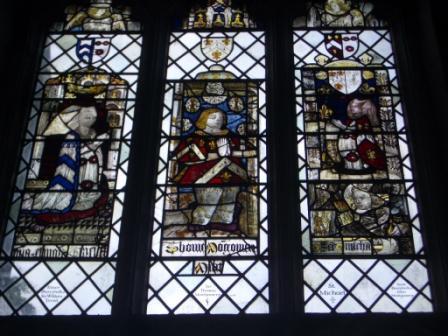
Holy Trinity Church, Long Melford
John Horton
On May 20th, a day of very uncertain weather, a dozen or so members of the Society and twice that number from Suffolk Heraldry Society visited Holy Trinity Church, Long Melford in the latter’s home territory. Some of us had travelled there not knowing what to expect. We needn’t have been concerned – we were treated to a fine collection of hatchments and a wonderful display of heraldry in stained glass, much of it mediaeval.

Holy Trinity Church, Long Melford
The church in its present form was re-built by the Clopton family in 1484. Not surprisingly, therefore, the simple but distinctive arms of Clopton, Sable a bend argent cotised dancetty or, occur throughout the church. They are particularly common in the windows over the north aisle. These windows show heraldry in several different styles. The most characteristic has knights with their arms on their surcoats (worn over their armour). The ladies wear their paternal arms on their kirtles (dresses) and their husbands’ arms on their mantles.
One of these windows is particularly well known. Lady Elizabeth Talbot, daughter of the first Earl of Shrewsbury, married the fourth (and last) Duke of Norfolk of the 1397 (Mowbray) creation. (Our Patron is a descendant of the first Duke of Norfolk of the 1483 (Howard) creation, himself a grandson of the first Mowbray duke). On her kirtle, therefore, she wears the Talbot lion (Gules a lion rampant within a bordure engrailed or) and her mantle shows the arms of Brotherton (Gules three lions passant guardant or a label of three points argent i.e. England differenced, since Thomas of Brotherton was a younger son of King Edward I). However, it is not for the arms that this image is well known. Rather, it is believed by some to have been the inspiration for John Tenniel’s drawing of the Duchess in Lewis Carroll’s Alice’s Adventures in Wonderland. (Disappointingly, the less romantically-minded claim Tenniel based his work on a sixteenth century Flemish painting.)

Window 1 (North Aisle) – The “John Tenniel Window” – The shield shows Mowbray (Gules a lion rampant argent). The ladies are the wife of the fourth (and last) Duke of Norfolk of the 1397 (Mowbray) creation (see text) and the wife of the second Duke of Norfolk of the 1483 (Howard) creation. The latter wears Tilney (Azure a chevron between three griffins’ heads erased or), her paternal arms, on her kirtle and her husband’s arms on her mantle. The latter are First and fourth Gules a bend between six crosses crosslet fitchy argent (Howard); second and third grand quarterly first and fourth Brotherton second and third Mowbray
At the east end of the north aisle is the Clopton Chantry Chapel, renovated in recent years with money from America. One of our guides told us that, though there are numerous Cloptons in America, they seem to have disappeared from this country!
Nearby, in the chancel are memorials to a second local family of note – the Hyde Parkers, a naval family. It was an Admiral Sir Hyde Parker who was Nelson’s commanding officer at Copenhagen (1801) and who sent a signal to the fleet to “discontinue the action”. Nelson disregarded the signal (supposedly turning his blind eye to it) and instead led the fleet to victory. Shortly afterwards, the unfortunate admiral was ordered to surrender his command to his second-in-command and return to England never to see service again.

Window 7 (North Aisle) (Left) Tyrell (Argent two chevrons azure a bordure engrailed gules) impaling D’Arcy (Argent [sic ] three cinquefoils pierced gules ). (Centre) Montgomery (Argent a chevron ermine between three fleurs-de-lys or) though with the field missing from the shield. (Right) Montgomery impaling D’Arcy
There are eight hatchments in the base of the tower and some of these have Hyde Parker connections too. The oldest hatchment, however, is near the main door and this commemorates the first Viscount Savage. Besides two supporters and a viscount’s coronet, it has two crests and a shield impaling twenty-one quarters with a further twelve! It dates from 1635 and is one of the oldest hatchments in Suffolk. (The viscountcy became extinct in 1728 on the death of the fifth Earl Rivers who was also the fifth Viscount Savage. The first viscount had been heir apparent to his father-in-law but, predeceasing him, never inherited the latter’s peerage titles – see Nicolas and Courthope, page 421 and page 400.)
After the tour was over, we were able to buy tea, cake and biscuits from the Friends of Long Melford Church and visit the bookshop at the west end of the south aisle.

(Foreground, left to right) Derek Palgrave, Tom West and Antti Matikkala have tea with Gerry de Roeper of the Suffolk Heraldry Society (second from left).
The Suffolk Heraldry Society has produced a guide to the heraldry of the church and this lists 150 distinct coats in approximately 50 settings (whether windows, hatchments or other forms of memorial.) This brief report can give only a flavour of what there is to see at Long Melford. It is no coincidence, for instance, that Plate 10B of Hargreaves-Mawdsley’s book on legal dress shows a Long Melford window. Any members of the Society finding themselves in the vicinity should seriously consider making a visit – they will not be disappointed.
Return to:
Contact Officers of the Society by e-mail.
Cambridge University Heraldic and Genealogical Society